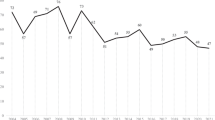Abstract
Both conflict tactics and injuries resulting from marital violence were assessed for both members of the dyad in a sample of 180 couples referred to a treatment program for domestic violence in three military bases. Though both men and women reported engaging in topographically similar aggressive acts, the percentage of women reporting injuries, especially severe injuries, was much higher than the corresponding percentage of men. Injuries were also related to use of more severe aggressive behaviors as assessed by the Conflict Tactics Scale. These results provide support for conceptualizations of spouse abuse which stress the importance of addressing impact dimensions of aggression in addition to topographic dimensions in comparing this phenomenon across genders.
Similar content being viewed by others
References
Cascardi, M., Langhinrichsen, J., and Vivian, D. (1992). Marital aggression: Impact injury, and health correlates for husbands and wives.Arch. Int. Med. 152: 1178–1184.
Gelles, R. J., and Conte, J. R. (1990). Domestic violence and sexual abuse of children: A review of research in the eighties.J. Marr. Fam. 52: 1045–1058.
Jouriles, E. N., and O'Leary, K. D. (1985). Interpersonal reliability of reports of marital violence.J. Consult. Clin. Psychol. 53: 419–421.
Koss, M. P. (1990). The women's mental health research agenda: Violence against women.Am. Psychologist 45: 374–380.
McNeely, R. L., and Robinson-Simpson, G. (1987). The truth about domestic violence: A falsely framed issue.Social Work 32: 485–490.
Mills, M. E. (1990). The new heretics: Men.Am. Psychologist 45: 675–676.
Mould, D. E. (1990). Data base or data bias?Am. Psychologist 45: 676.
Neidig, P. H. (1984). Spouse abuse: A causal model with assessment procedures. (Available from Behavioral Science Associates, P.O. Box 87, Stony Brook, New York, 11790)
O'Leary, K. D., and Arias, I. (1988). Assessing agreement of reports of spouse abuse. In Hotaling, G., Finkelhor, D., Kilpatrick, J. T., and Straus, M. A. (eds.),Family Abuse and Its Consequences: New Directions in Research, Sage, Newbury Park, CA, pp. 218–227.
O'Leary, K. D., Barling, J., Arias, I., Rosenbaum, A., Malone, J., and Tyree, A. (1989). Prevalence and stability of physical aggression between spouses.J. Consult. Clin. Psychol. 57: 263–268.
O'Leary, K. D., Vivian, D., and Malone, J. (1992). Assessment of physical aggression against women in marriage: The need for a multimodal method.Behav. Assess. 14, 5–14.
O'Leary, K. D., and Curley, A. D. (1986). Assertion and family violence: Correlates of spouse abuse.J. Marit. Fam. Ther. 12: 281–290.
Pan, H., Neidig, P. N., and O'Leary, K. D. (in press). Male-female and aggressor-victim differences in the factor structure of the modified conflict tactics scale.J. Interpersonal Violence.
Saunders, D. G. (1986). When battered women use violence: Husband abuse or defense.Viol. Vict. 1: 47–60.
Stets, J. E., and Straus, M. A. (1990). Gender differences in reporting marital violence and its medical and psychological consequences. In Straus, M., and Gelles, R. (eds.),Physical Violence in American Families: Risk Factors and Adaptations in 8145 Families, Transaction Books, New Brunswick, NJ.
Straus, M. A. (1979). Measuring intrafamily conflict and violence: The conflict tactics scale.J. Marr. Fam. 41: 75–87.
Straus, M. A., Gelles, R. J., and Steinmetz, S. K. (1980).Behind Closed Doors: Violence in the American Family, Anchor Press, New York.
Straus, M. A. (1990). The conflict tactics scale and its critics: An evaluation and new data on validity and reliability. In Straus, M., and Gelles, R. J. (eds.),Physical Violence in American Families: Risk Factors and Adaptations in 8145 Families, Transaction Books, New Brunswick, NJ.
Walker L. E. A. (1989). Psychology and violence against women.Am. Psychologist 44: 695–702.
Author information
Authors and Affiliations
Rights and permissions
About this article
Cite this article
Cantos, A.L., Neidig, P.H. & O'Leary, K.D. Injuries of women and men in a treatment program for domestic violence. J Fam Viol 9, 113–124 (1994). https://doi.org/10.1007/BF01531958
Issue Date:
DOI: https://doi.org/10.1007/BF01531958



